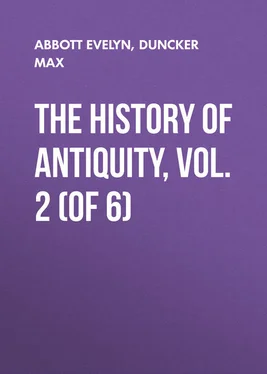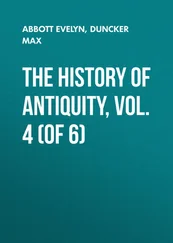Evelyn Abbott - The History of Antiquity, Vol. 2 (of 6)
Здесь есть возможность читать онлайн «Evelyn Abbott - The History of Antiquity, Vol. 2 (of 6)» — ознакомительный отрывок электронной книги совершенно бесплатно, а после прочтения отрывка купить полную версию. В некоторых случаях можно слушать аудио, скачать через торрент в формате fb2 и присутствует краткое содержание. Жанр: foreign_antique, foreign_prose, Историческая проза, на английском языке. Описание произведения, (предисловие) а так же отзывы посетителей доступны на портале библиотеки ЛибКат.
- Название:The History of Antiquity, Vol. 2 (of 6)
- Автор:
- Жанр:
- Год:неизвестен
- ISBN:нет данных
- Рейтинг книги:4 / 5. Голосов: 1
-
Избранное:Добавить в избранное
- Отзывы:
-
Ваша оценка:
- 80
- 1
- 2
- 3
- 4
- 5
The History of Antiquity, Vol. 2 (of 6): краткое содержание, описание и аннотация
Предлагаем к чтению аннотацию, описание, краткое содержание или предисловие (зависит от того, что написал сам автор книги «The History of Antiquity, Vol. 2 (of 6)»). Если вы не нашли необходимую информацию о книге — напишите в комментариях, мы постараемся отыскать её.
The History of Antiquity, Vol. 2 (of 6) — читать онлайн ознакомительный отрывок
Ниже представлен текст книги, разбитый по страницам. Система сохранения места последней прочитанной страницы, позволяет с удобством читать онлайн бесплатно книгу «The History of Antiquity, Vol. 2 (of 6)», без необходимости каждый раз заново искать на чём Вы остановились. Поставьте закладку, и сможете в любой момент перейти на страницу, на которой закончили чтение.
Интервал:
Закладка:
On the coasts of Syria were settled the tribes of the Arvadites, Giblites and Sidonians (I. 344). Their land extended from the mouth of the Eleutherus (Nahr el Kebir) in the north to the promontory of Carmel in the south. A narrow strip of coast under Mount Lebanon, from 10 to 15 miles in breadth and some 150 miles in length, was all that they possessed. Richly watered by the streams sent down from Lebanon to the sea, the small plains formed round their mouths and separated by the spurs of the mountain ranges are of the most abundant fertility. The Eleutherus is followed to the south by the Adonis (Nahr el Ibrahim), and this by the Lycus (Nahr el Kelb); then follow the Tamyras (Nahr Damur), the Bostrenus (Nahr el Auli 63 63 Robinson, "Palestine," 3, 710.
), the Belus (the Sihor Libnath of the Hebrews, now Nahr Naman), and lastly the Kishon. Above the shore rise hills clothed with date-palms, vines and olives; higher up on Lebanon splendid mountain pastures spread out, and above these we come to the vast forests (I. 338) which provide shade in the glowing heat, as Tacitus says, 64 64 Tac. "Hist." 5, 6.
and to the bright snow-fields which crown the summit of Lebanon. Ammianus speaks of the region under Lebanon as full of pleasantness and beauty. The upper slopes of the mountain furnish pasture and forests; in the rocks are copper and iron. The high mountain-range, which sharply divided the inhabitants of the coast from the interior (at a much later time, even after the improvements of the Roman Cæsars, there were, as there are now, nothing but mule-tracks across Lebanon 65 65 Rénan, "Mission de Phénicie," p. 836.
), lay behind the inhabitants of the coast, and before them lay the sea. At an early period they must have become familiar with that element. The name of the tribe which the Hebrew Scriptures call the "first-born of Canaan" means "fishermen." The places on the coast found the sea the easiest means of communication. Thus the sea, so rich in islands, the long but proportionately narrow basin which lay before the Sidonians, Giblites and Arvadites, would soon attract to longer voyages the fishermen and navigators of the coast.
We found that the beginning of civilisation in Canaan could not be placed later than about the year 2500 B.C., and we must therefore allow a considerable antiquity to the cities of the Sidonians, Giblites, Arvadites, Zemarites and Arkites. The settlement on the site of Sidon was founded, no doubt, before the year 2000 B.C., and that on the site of Byblus cannot certainly be placed later than this period. 66 66 Vol. i. pp. 344, 345.
The campaigns which the Pharaohs undertook against Syria and the land of the Euphrates after the expulsion of the Shepherds could not leave these cities unmoved. If the Zemar of the inscriptions of Tuthmosis III. is Zemar (Simyra) near Aradus, and Arathutu is Aradus itself, the territories of these cities were laid waste by this king in his sixth campaign (about the year 1580 B.C.); if Arkatu is Arka, south of Aradus, this place must have been destroyed in his fifteenth campaign (about the year 1570 B.C.). Sethos I. (1440-1400 B.C.) subdued the land of Limanon ( i. e. the region of Lebanon), and caused cedars to be felled there. One of his inscriptions mentions Zor, i. e. Tyre, among the cities conquered by him. The son and successor of Sethos I., Ramses II., also forced his way in the first decades of the fourteenth century as far as the coasts of the Phenicians. At the mouth of the Nahr el Kelb, between Sidon and Berytus, the rocks on the coast display the memorial which he caused to be set up in the second and third year of his reign in honour of the successes obtained in this region. 67 67 Vol. i. p. 151.
In the fifth year of his reign Ramses, with the king of the Cheta' defeats the king of Arathu in the neighbourhood of Kadeshu on the Orontes, and Ramses III. about the year 1310 B.C., mentions beside the Cheta who attack Egypt the people of Arathu, by which name, in the one case as in the other, may be meant the warriors of Aradus. 68 68 Vol. i. p. 153.
If Arathu, like Arathutu, is Aradus, it follows, from the position which Ramses II. and III. give to the princes of Arathu, that beside the power to which the kingdom of the Hittites had risen about the middle of the fifteenth century B.C., and which it maintained to the end of the fourteenth, 69 69 Vol. i. p. 344.
the Phenician cities had assumed an independent position. The successes of the Pharaohs in Syria come to an end in the first decades of the fourteenth century. Egypt makes peace and enters into a contract of marriage with the royal house of the Cheta; the Syrians obtain even the preponderance against Egypt (I. 152), to which Ramses III. towards the end of the fourteenth century was first able to oppose a successful defence.
The overthrow of the kingdom of the Hittites, which succumbed to the attack of the Amorites (I. 348) soon after the year 1300 B.C., must have had a reaction on the cities of the Phenicians. Expelled Hittites must have been driven to the coast-land, or have fled thither, and in the middle of the thirteenth century the successes gained by the Hebrews who broke in from the East, over the Amorites, the settlement of the Hebrews on the mountains of the Amorites, must again have thrown the vanquished, i. e. the fugitives of this nation, towards the coast.
With this retirement of the older strata of the population of Canaan to the coast is connected the movement which from this period emanates from the coasts of the Phenicians, and is directed towards the islands of the Mediterranean and the Ægean. It is true that on this subject only the most scanty statements and traces, only the most legendary traditions have come down to us, so that we can ascertain these advances only in the most wavering outlines. One hundred miles to the west off the coast of Phœnicia lies the island of Cyprus. On the southern coast of this island, which looked towards Phœnicia, stood the city of Citium, Kith and Chith in the inscriptions of the Phenicians, and apparently Kittii in those of the Assyrians. Sidonian coins describe Citium as a daughter of Sidon. 70 70 The legend runs, "From the Sidonians, Mother of Kamb, Ippo, Kith(?), Sor," Movers, "Phœniz." 2, 134.
After this city the whole island is known among the Semites as Kittim and Chittim; this name is even used in a wider sense for all the islands of the Mediterranean. 71 71 Isaiah xxiii. 1, 19; Jeremiah ii. 10; Ezekiel xxvii. 6; Joseph. "Antiq." 1, 6, 1.
The western writers state that before the time of the Trojan war Belus had conquered and subjugated the island of Cyprus, and that Citium belonged to Belus. 72 72 Virgil, "Æn." 1, 619, 620.
The victorious Belus is the Baal of the Phenicians. The date of the Trojan war is of no importance for the settlement of the Phenicians in Cyprus, for this statement is found in Virgil only. More important is the fact that the settlers brought the Babylonian cuneiform writing to Cyprus. This became so firmly rooted in use that even the Greeks, who set foot on the island at a far later time, scarcely before the end of the ninth century, adopted this writing, which here meanwhile had gone through a peculiar development, and had become a kind of syllabic-writing, and used it on coins and in inscriptions even in the fifth century B.C. 73 73 Brandis, "Monatsberichte Berl. Akad." 1873, s. 645 ff.
The settlement of the Sidonians in Cyprus must therefore have taken place before the time in which the alphabetic writing, i. e. the writing specially known as Phenician, was in use in Syria, and hence at the latest before 1100 B.C. How long before this time the settlement of the Phenicians in Cyprus took place can, perhaps, be measured by the fact that the Cyprian alphabet is a simplification of the old Babylonian cuneiform writing. The simplified form would undoubtedly have been driven out by the far more convenient alphabetic writing of the Phenicians if the Cyprian writing had not become fixed in use in this island before the rise of the alphabetic writing. Further, since the Phenicians, as we shall see, set foot on the coast of Hellas from about the year 1200 B.C. onwards, we must place the foundation of the colonies on the coasts nearest them, the settlement in Cyprus, before this date, about the middle of the thirteenth century B.C.
Интервал:
Закладка:
Похожие книги на «The History of Antiquity, Vol. 2 (of 6)»
Представляем Вашему вниманию похожие книги на «The History of Antiquity, Vol. 2 (of 6)» списком для выбора. Мы отобрали схожую по названию и смыслу литературу в надежде предоставить читателям больше вариантов отыскать новые, интересные, ещё непрочитанные произведения.
Обсуждение, отзывы о книге «The History of Antiquity, Vol. 2 (of 6)» и просто собственные мнения читателей. Оставьте ваши комментарии, напишите, что Вы думаете о произведении, его смысле или главных героях. Укажите что конкретно понравилось, а что нет, и почему Вы так считаете.












